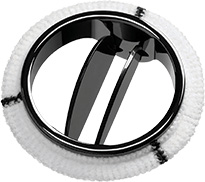Implant Confidently
The Regent™ aortic mechanical valve offers surgeon-friendly implantability, featuring a low valve implant height that helps ensure coronary ostia clearance. Two distinct cuff types—FlexCuff™ or Standard Cuff—provide different options. The Regent™ valve features exceptional hemodynamics in small aortic root patients.1*
Because prosthesis-patient mismatch (PPM) can be problematic in the aortic position, Abbott designed the Regent™ valve specifically to avoid this issue. The orifice-to-annulus ratio of the Regent™ valve ensures large effective orifice areas (EOAs) and reduces PPM.2
The Regent™ valve shows low thromboembolism, thrombosis, and bleeding over a wide international normalized ratio (INR) range, making this valve an excellent choice.3-6
*Measured one year post-surgery.
Learn about the features of the Regent™ Aortic Mechanical Heart Valve.

Confidently Implant the Most Trusted Mechanical Valves in the World.
Ordering Information
Regent™ Aortic Mechanical Heart Valve
| Catalog Number | Tissue Annulus Diameter (mm) | Geometric Orifice Area (cm²) | Implant Height Open (mm) | Overall Height Open (mm) | Cuff Outer Diameter (mm) |
|---|---|---|---|---|---|
| Standard Cuff | |||||
| 17 AGN‑751 | 17 | 1.9 | 6.1 | 11.6 | 24.7 |
| 19 AGN‑751 | 19 | 2.4 | 6.1 | 11.6 | 24.7 |
| 21 AGN‑751 | 21 | 2.9 | 7.3 | 13.0 | 26.7 |
| 23 AGN‑751 | 23 | 3.5 | 8.0 | 14.3 | 28.7 |
| 25 AGN‑751 | 25 | 4.0 | 8.2 | 14.6 | 30.7 |
| 27 AGN‑751 | 27 | 4.7 | 9.1 | 15.4 | 32.7 |
| FlexCuff™ | |||||
| 17 AGFN‑756 | 17 | 1.9 | 6.1 | 11.6 | 24.7 |
| 19 AGFN‑756 | 19 | 2.4 | 6.1 | 11.6 | 27.0 |
| 21 AGFN‑756 | 21 | 2.9 | 7.3 | 13.0 | 29.0 |
| 23 AGFN‑756 | 23 | 3.5 | 8.0 | 14.3 | 31.0 |
| 25 AGFN‑756 | 25 | 4.0 | 8.2 | 14.6 | 33.0 |
| 27 AGFN‑756 | 27 | 4.7 | 9.1 | 15.4 | 35.0 |
References
- Regent PMA Supplement.
- Pibarot P, Dumesnil JG. Hemodynamic and clinical impact of prosthesis-patient mismatch in the aortic valve position and its prevention. J Am Coll Cardiol. 2000;36(4):1131-1141. doi.org/10.1016/s0735-1097(00)00859-7.
- Bach DS, Sakwa MP, Goldbach M, et al. Hemodynamics and early clinical performance of the St. Jude Medical Regent mechanical aortic valve. Ann Thorac Surg. 2002;74(6):2003-2009.
- Torella M, Torella D, Chiodini P, et al. LOWERing the INtensity of oral anticoaGulant Therapy in patients with bileaflet mechanical aortic valve replacement: results from the "LOWERING-IT" Trial. Am Heart J. 2010;160(1); 171-178. doi: 10.1016/j.ahj.2010.05.005
- Koertke H, Zittermann A, Wagner O, et al. Efficacy and safety of very low-dose self-management of oral anticoagulation in patients with mechanical heart valve replacement. Ann Thorac Surg. 2010;90(5):1487-1493.
- Emery RW, Krogh CC, Arom KV, et al. The St. Jude Medical cardiac valve prosthesis: a 25-year experience with single valve replacement. Ann Thorac Surg. 2005;79(3):776-82. doi: 10.1016/j.athoracsur.2004.08.047
Regent™ Mechanical Heart Valve

Indications for Use
The SJM Regent™ Mechanical Heart Valve is intended for use as a replacement valve in patients with a diseased, damaged, or malfunctioning aortic valve. This device may also be used to replace a previously implanted aortic prosthetic valve.
Contraindications
The SJM Regent™ Mechanical Heart Valve is contraindicated for individuals unable to tolerate anticoagulation therapy.
Potential Adverse Events
Complications are associated with replacement mechanical heart valves include, but are not limited to, hemolysis, infections, thrombus, or thromboembolism, valve dehiscence, unacceptable hemodynamic performance, hemorrhagic complications secondary to anticoagulation therapy, prosthetic failure, heart failure or death. Any of these complications may require reoperation or explantation of the device.
MAT-2011657 v2.0
